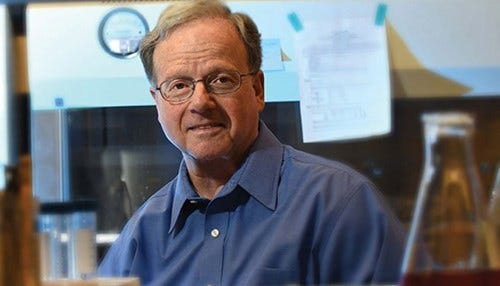Legendary IU Researcher Aims to Break New Ground
 The prestigious grant gives Broxmeyer freedom to seek the most promising path for cord blood transplant research.
The prestigious grant gives Broxmeyer freedom to seek the most promising path for cord blood transplant research.
Subscriber Benefit
As a subscriber you can listen to articles at work, in the car, or while you work out. Subscribe NowCord blood stem cell transplants have saved the lives of countless children—more than 40,000—because of a discovery made at Indiana University School of Medicine (IUSM) in the 1980s, but like most science, it’s not perfect. However, the discovery-maker himself, Dr. Hal Broxmeyer, is determined to improve umbilical cord blood transplants, and he recently earned a prestigious $5.4 million dollar grant—likened to a lifetime achievement award—that could help him tweak the technology to save thousands more.
Doctors performed the first successful cord blood stem cell transplant in Paris, France, in 1988. Broxmeyer bought two plane tickets; one for him and one for the special canister—about the size of a mini-fridge—to sit beside him, so be could hand-deliver the stem cells himself. His discoveries paved the way for thousands of cord blood stem cell transplants since, saving patients—mostly children—with some 70 diseases, including various types of leukemia and Hodgkin and non-Hodgkin lymphoma.
“All blood cells in your body, which you need to live…come from the bone marrow (inside of the bone),” says Broxmeyer, who is an IUSM professor of microbiology/immunology. “The cells come from a very rare population of cells: hematopoietic stem cells (HSCs). If you run out of HSCs, you can no longer make the blood cells, you get diseases, and/or you will die. [HSCs] are very important, but they’re very rare.”
Bone marrow transplantation, in which HSCs are taken from a person’s bone marrow who is a “match” with the patient, earned its discoverers the Nobel Prize in 1990, but it has drawbacks. A match can be difficult to find, donation is an invasive procedure, and the marrow may not be obtained in time if needed immediately. Therefore, Broxmeyer’s discovery that HSCs could also be identified in umbilical cord blood after a baby’s birth was groundbreaking.
Broxmeyer’s lab established the first proof-of-principle cord blood bank, and such banks eventually became a multi-billion dollar industry. A critical advantage is HSCs obtained from cord blood can be used on patients who aren’t a perfect match, unlike HSCs obtained from bone marrow.
“But while cord blood has advantages,” says Broxmeyer, “it has disadvantages, compared to bone marrow and mobilized peripheral blood (a third source for the rare stem cells).”
The highly competitive National Heart, Lung, and Blood Institute Outstanding Investigator Award gives Broxmeyer $5.4 million in research funds and freedom—uncommon in the world of scientific research—to choose what path he believes is best for his studies.
One challenge facing cord blood transplantation is the time to engraftment, which is the process of stem cells entering the blood and making their way to the bone marrow to start making new blood cells; this can take two to six weeks. Broxmeyer’s lab is searching for ways to speed the process.
A second focus is increasing the number of stem cells that can be collected from cord blood. Only a small amount of cord blood can be obtained after the birth of a baby, but Broxmeyer’s lab discovered if the cells are collected in low oxygen and never hit ambient air, up to five times as many cells can be collected. But Broxmeyer jokes that mothers can’t be placed in low oxygen chambers, so he’s searching for a method that’s more practical.
His lab discovered collecting the blood in the presence of a specific molecule blocks the cells’ response to ambient air and protects the high number of stem cells, but Broxmeyer says, “it’s still not perfect, because every batch of this (small molecule) is a little different. It’s very hard to find the right concentration.” And so his quest for perfection continues.
“Another way is to expand the stem cells outside the body, or increase the ability of stem cells once you inject them in the recipient to find their way back to the bone marrow, so they grow better,” says Broxmeyer. “We’re trying to put this all together. Can you collect cells in a way that the air doesn’t induce their differentiation? And can you take these cells, expand them outside the body, and increase the cells’ ability to get to the bone marrow?”
Such is the nature of science that one question leads to many more, but Broxmeyer is no stranger to searching for answers. Fueled by more funding than ever before and freedom to seek the most promising path for cord blood transplants, it’s likely his influence is far from over.
Broxmeyer says the award is one of the proudest achievements in his career.
Broxmeyer says his work in cord blood stem cell transplants has expanded into other areas, forging connections throughout the United States.
